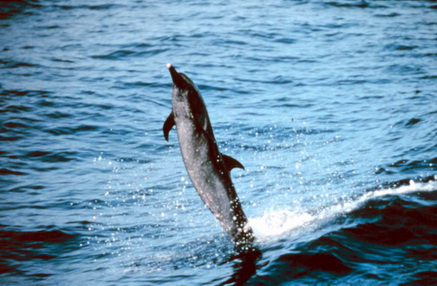|
| 질의: fin whale | 결과: 175번째/177 | |
Pantropical Spotted Dolphin (Stenella attenuata) - Wiki
| 제목: | Pantropical Spotted Dolphin (Stenella attenuata) - Wiki
| |

| 해상도: 437x286
파일크기: 61819 Bytes
촬영일: 2007:08:14 17:44:17
등록시간: 2007:08:14 17:46:47
|
Pantropical Spotted Dolphin
From Wikipedia, the free encyclopedia
[Photo] Pantropical spotted dolphin skipping on its tail over the water. Stenella attenuata.
The Pantropical Spotted Dolphin (Stenella attenuata) is a species of dolphin found in all the world's temperate and tropical oceans. The species was beginning to come under threat due to the killing of millions of individuals in tuna purse seines. The 1980s saw the rise of "dolphin-friendly tuna [capturing methods]" in order to save millions of the species in the eastern Pacific Ocean.
Taxonomy
The species was first identified by John Gray in 1846. Gray's initial analysis included the Atlantic Spotted Dolphin in this species. They are now regarded as separate. Both the genus and specific names come from Latin words meaning thin or thinning.
There are three subspecies recognised in Rice's 1998 survey of cetacea taxonomy. Two of these have not been formally named
S. a. subspecies A, the off-shore form found in the eastern Pacific
S. a. subspecies B, a form found around the Hawaiian islands.
S. a. graffmani, coastal form found from Mexico to Peru
Physical description
The Pantropical Spotted Dolphin varies significantly in size and colaration throughout its range. The most significant division is between coastal and pelagic varieties. The coastal form is larger and more spotted. (These two forms have been divided into subspecies only in eastern Pacific populations ??? see taxonomy above).
Spots are key defining characteristics in adults, though immature individuals are generally uniformly coloured and susceptible to confusion with the Bottlenose Dolphin. Populations around the Gulf of Mexico may be relatively spot-free even in adulthood. In the Atlantic, confusion is possible with the Atlantic Spotted Dolphin.
Broadly speaking the Dolphin has a long thin beak. The upper and lower jaws are darkly coloured but are separated by thin white "lips". The chin, throat and belly are white to pale grey with a limited amount of spots. The flanks are separated into three distinct bands of colour ??? the lightest at the bottom, followed by a thin grey strip in the middle of the flank and a dark grey back. The tall concave dorsal fin is similarly coloured. The thick tail stock matches the colour of the middle band.
The Pantropical Spotted Dolphin is very active and is prone to making large splashy leaps from the sea. It is a common breacher and will often clear the water for a second or more. Bow-riding and other play with boats is common.
In the eastern Pacific, the Dolphin is often found swimming with Yellowfin Tuna (hence the problem with dolphin deaths caused by tuna fishing ??? see the Human interaction section). However they do not feed on that fish. In fact the two species have a similar diet of small epipelagic fish. In other areas the species may also feed on squid and crustaceans.
Birth length is 80-90 cm. Adults are about 2.5 m long and weigh 120 kg. Sexual maturity is reached at 10 years in females and 12 years in males. Lifespan is approximately 40 years.
Population and distribution
The Pantropical Spotted Dolphin, as its very name proclaims, is found across all tropical and sub-tropical waters around the world ??? roughly speaking all oceans and seas between 40° N and 40° S. The total world population is in excess of three million ??? the second most abundant cetacean after the Bottlenose Dolphin ??? of which two million are found in the eastern Pacific. However this represents a decrease from at least 7 million since the 1950s.
Centres of highest population density are the shallow warmest waters (water temperature in excess of 25 °C). There is also a tendency for groups to concentrate where there is a high temperature gradient.
Human interaction
The Pantropical Spotted Dolphin's propensity for associating with Yellowfish Tuna, particularly in the eastern Pacific has in recent history been a very real danger. In the 1960s and 1970s fishermen would capture thousands of dolphin and tuna at once using purse seine nets. The dolphins all died. Over a period of about 25 years 75% of this region's population, and over half the world's total was wiped out. The issue has received wide public attention. Many major supermarkets have found it economically expedient to use tuna suppliers whose fisherman catch tuna by more discriminatory means, and thus advertise their tuna product as dolphin-friendly. Some such products are approved by the Whale and Dolphin Conservation Trust.
http://en.wikipedia.org/wiki/Pantropical_Spotted_Dolphin
| The text in this page is based on the copyrighted Wikipedia article shown in above URL. It is used under the GNU Free Documentation License. You may redistribute it, verbatim or modified, providing that you comply with the terms of the GFDL. |
|
댓글 |
|---|
| | 손님 |
|
Scientific Name: Stenella attenuata (Gray, 1846)
Common Names:
English – Pantropical Spotted Dolphin, Bridled Dolphin, Narrow-snouted Dolphin
French – Dauphin tacheté Pantropical
Spanish – Delfín Manchado, Delfín Pintado
Synonyms: Stenella graffmani Lönnberg, 1934 |
^o^
동물그림창고 똑똑전화 누리집
^o^
|
|
|